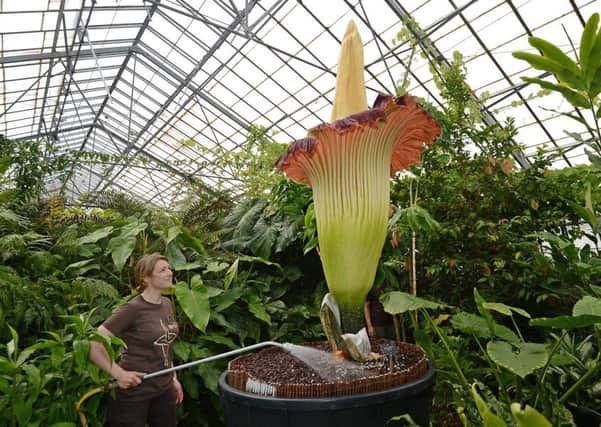World’s smelliest plant blooms after 12 years


And it is a phenomenon never seen before in Scotland.
The Amorphophallus titanum or Titan arum – which gives off a stench like rotting flesh to attract insects – generally flowers every seven to ten years but its spectacular bloom usually only lasts for a day.
And visitors are expected to flock to the attraction in their thousands today (Sunday) for a glimpse of the exotic bloom with the glasshouses open for 12 hours a day to the public.


Advertisement
Hide AdAdvertisement
Hide AdOn an average day in June, the gardens receive around 200 to 300 visitors to the glasshouses but this weekend that is expected to increase to between 3,000 and 4,000.
The plant, which has the heaviest corm ever recorded, weighing in at 153.9kg, has produced seven leaves so horticulturists are delighted to finally have a flower.
Senior horticulturist Sadie Barber, who was gifted the corm in 2003 by Hortus Botanicus in Leiden, the Netherlands, said: “We are thrilled to finally see, and smell, this incredible curiosity of the plant world after 12 years of careful cultivation by the Horticulture team at RBGE.
“The spadix has so far reached an impressive height of more than eight feet and may even grow a few centimetres more in the next days.
Advertisement
Hide AdAdvertisement
Hide Ad“It really is one of the most extraordinary flowering plants we have ever seen, and great to think that something that grows naturally so far away can be enjoyed by visitors to the garden here in Edinburgh.”
She added: “The full bloom only lasts one or two days so visitors should hurry to catch the spectacle while they can.”
Tropical botanist Mark Hughes said: “The Titan arum grows only on the Indonesian island of Sumatra, and its flowering here in RBGE symbolises our research and conservation efforts in that country.
“We have another 440 species of plants in our glasshouses from Indonesia, many of them incredibly rare and endangered but also fascinating and beautiful.
Advertisement
Hide AdAdvertisement
Hide Ad“In the past five years our scientists have described over 50 new species from Indonesian forests, showing how much remains to be discovered and protected for the future.”
The Titan arum is a giant among plants, with a massive flowering structure that rises some ten feet above the ground. Successfully bringing the Titan arum to the point of flowering has involved recreating the conditions it would experience in the rainforests of Sumatra.
During the day the temperatures are between 21C and 25C, and by night the minimum is 19C with about 80 per cent humidity.
Often an Titan arum will die after flowering, but with careful cultivation a plant can continue to produce more leaves or flowers in future years.
Advertisement
Hide AdAdvertisement
Hide AdAnother Titan arum blossomed in Paignton Zoo in Devon on Thursday night, displaying a bloom almost ten feet wide and ten feet tall.
Ultimately, the flower will be added to the Botanic Garden’s herbarium which includes more than three million specimens.
First it will be specially dried, pressed and treated so it “lasts forever” and the horticulturists of the future will be able to study it.
The Titan arum is only known from the Bukit Barisan range of mountains in west Sumatra and is classified as “vulnerable” on International Union for Conservation of Nature red list of threatened plants.